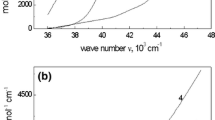Abstract
The anodic dissolution of gold in alkaline thiosulfate solutions has been studied by using a rotating gold disc. Experimental results have shown that the gold dissolves at measurable rates in thiosulfate solutions at potentials above 0.2 V. It has been confirmed that dissolution occurs in parallel with oxidation of thiosulfate with a dissolution current efficiency that varies with time and with the experimental conditions and which is generally in the range of 0.3 to 0.6. Although oxygen could be used as an oxidant for gold in the thiosulfate system, the rate of the cathodic reduction of oxygen in the relevant potential region is too slow for practical purposes. It was found that in the potential region investigated, thiosulfate ions undergo oxidative decomposition leaving a sulfur-like film on the surface of gold, which inhibits the rate of dissolution of gold and results in a low anodic current efficiency for the dissolution of gold. The factors (temperature, pH, thiosulfate concentration and ammonia) have been found to have positive effects on the kinetics of gold dissolution. The rates of gold dissolution in oxygenated alkaline thiosulfate solutions have been estimated to be much lower than in the copper–ammonia–thiosulfate and cyanide systems.
Similar content being viewed by others
References
M.G. Aylmore and D.M. Muir, Minerals Eng. 14 (2001) 135.
R.M. Berezowsky, V.B. Sefton and L.S. Gormely, US Patent 4 070 182 (1978).
R.M. Berezowsky and V.B. Sefton, Paper presented at 108th AIME Annual Meeting, New Orleans, Louisianna (1979) p. 102.
J.B. Hiskey and V.P. Atluri, Mineral Process. Extractive Metall. Rev. 4 (1988) 95.
A.J. Bard, 'Encyclopedia of Electrochemistry of the Elements', Vol. 4 (Marcel Dekker, New York, 1975), chapter 3.
H.A. White, J. Chem. Metall. Min. Soc. of South Africa 5 (1905) 109.
J.G. Webster, Geochim. et Cosmochim. Acta 50 (1986) 1837.
T. Jiang, S. Xu, J. Chen and Z. Wu, Huangjin 12 (1991) 41 (in Chinese).
T. Jiang, J. Chen and S. Xu, in Proceedings of XVIII International Mineral Processing Congress (AusIMM, Sydney, May 1993), p. 1141.
T. Jiang, J. Chen and S. Xu, in J.B. Hiskey and G.W. Warren (Eds), ‘Hydrometallurgy Fundamentals, Technology and Innovations’ (SME, Littleton, CO, 1993), chapter 7, p. 119.
G. Zhu, Z. Fang and J. Chen, Trans. Nonferrous Met. Soc. China 4 (1994) 50.
J. Chen, T. Deng, G. Zhu and J. Zhao, Trans. Indian Inst. Met. 49 (1996) 841.
I.A. Zhuchkov and P.P. Bubeyev, Izv. Vyssh. Uchebn. Zaved., Tsvetn. Metall. 4 (1994) 123.
I.A. Zhuchkov and P.P. Bubeev, Izv. Vyssh. Uchebn. Zaved., Tsvetn. Metall. 2 (1990) 64.
O. Barbosa Filho, R.B.E. Trindade and V.V. Araujo, Proceedings of the 49th Annual Congress of the Association of Brass Metal. Mater., Vol. 4 (1994), p. 265.
M.I. Jeffrey, Hydrometallurgy 60 (2001) 7.
M.J. Nicol, Gold Bulletin 13 (1980) 105.
D.G. Wierse, M.M. Lohrengel and J.W. Schultze, J. Electroanal. Chem. 92 (1978) 121.
T. Loucka, Collect. Czech. Chem. Commun. 63 (1998) 20.
A.M. Pedraza, I. Villegas, P.L. Freund and B. Chornik, J. Electroanal. Chem. 250 (1998) 443.
M. Pourbaix, 'Atlas of Electrochemical Equilibria in Aqueous Solutions', translated by J.A. Franklin (National Association of Corrosion Engineers, Houston, TX, 1974).
I.C. Hamilton and R. Woods, J. Appl. Electrochem. 13 (1983) 783.
X. Meng and K.N. Han, in J.B. Hiskey and G.W. Warren (Eds), ‘Hydrometallurgy Fundamentals, Technology and Innovations’ (SME, Littleton, Colorado, 1993), chapter 7, p. 205.
M.I. Jeffrey and P.L. Breuer, Minerals Eng. 13 (2000) 1097.
D. Lyons and G. Nickless in G. Nickless (Ed.) 'Inorganic Sulphur Chemistry', (Elsevier, New York, 1968), p. 509.
Y.C. Guan and K.N. Han, J. Electrochem. Soc. 143 (1996) 1875.
Author information
Authors and Affiliations
Corresponding author
Rights and permissions
About this article
Cite this article
Zhang, S., Nicol, M. An electrochemical study of the dissolution of gold in thiosulfate solutions Part I: Alkaline solutions. Journal of Applied Electrochemistry 33, 767–775 (2003). https://doi.org/10.1023/A:1025502303122
Issue Date:
DOI: https://doi.org/10.1023/A:1025502303122




